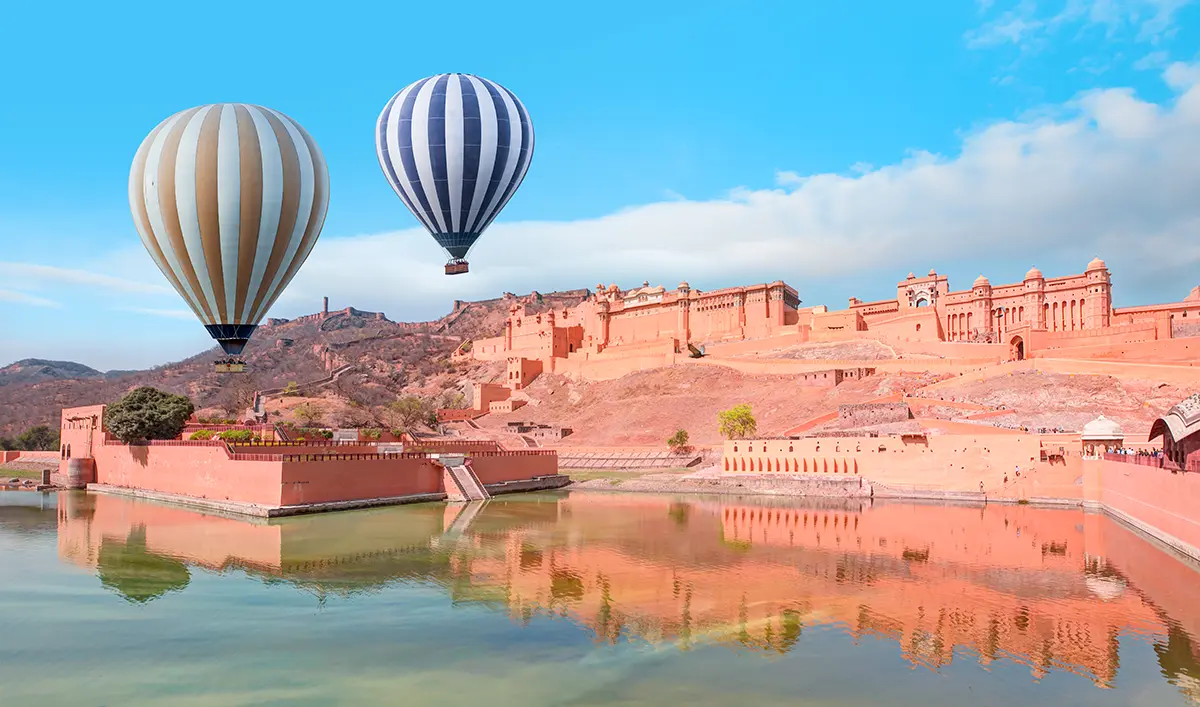
The majestic Amber Fort in Rajasthan, an UNESCO World Heritage Site showcasing Rajput architecture with colorful hot air balloons drifting overhead
© muratart / Adobe Stock
Rajasthan, India's largest state and the realm of legendary Rajput warriors and maharajas, embodies the romantic India of travelers' imaginations—golden deserts where camel caravans still cross sand dunes, imposing hilltop forts and opulent palaces showcasing centuries of royal grandeur, colorful bazaars overflowing with textiles and handicrafts, and a living culture where turbaned men with magnificent mustaches and women in brilliant saris maintain traditions unchanged for generations. From Jaipur's pink-walled old city and Udaipur's shimmering lake palaces to Jaisalmer's honey-colored desert fort and Jodhpur's blue-painted houses clustered beneath Mehrangarh Fort, Rajasthan delivers spectacular architecture, vibrant culture, and desert landscapes unlike anywhere else on Earth.Read moreRead less
Discover Rajasthan
Things to Do & Experience
Explore Jaipur's Amber Fort with elephant rides and mirror palaces, climb Mehrangarh Fort's ramparts in Jodhpur for panoramic blue city views, wander Udaipur's City Palace with lake views, and discover Jaisalmer's living fort where families still reside in 12th-century sandstone walls. Stay in heritage hotels (converted palaces and havelis), tour royal museums, and experience the grandeur of Rajput maharajas who ruled these desert kingdoms for centuries.
Ride camels into Sam Sand Dunes near Jaisalmer for sunset over golden desert, sleep under stars at luxury desert camps with folk music and dance performances, explore remote desert villages where life continues unchanged, and experience the stark beauty of the Thar Desert. Choose from day trips to multi-day camel treks, jeep safaris, and overnight camping combining adventure with cultural immersion in India's desert frontier.
Attend Pushkar's legendary camel fair (November), bathe in holy lakes at Pushkar's ghats, visit Ajmer's Dargah Sharif shrine, witness aarti ceremonies at Brahma Temple, and explore Jain temples carved from white marble at Ranakpur and Dilwara. Experience Hindu pilgrimage traditions, visit colorful festivals celebrating local deities, and discover the living religious culture that shapes daily life across Rajasthan.
Spot Bengal tigers on safari drives through Ranthambore National Park's forests and fort ruins, watch wildlife at waterholes including leopards and sloth bears, photograph hundreds of bird species, and combine wildlife viewing with ancient history as tigers roam 10th-century cenotaphs and pavilions. March-May offers peak tiger viewing as heat brings cats to water, creating some of India's most reliable tiger encounters.
Haggle for gems in Jaipur's wholesale markets (global gemstone trading center), buy block-printed textiles and blue pottery, commission custom-tailored clothing in 24 hours, shop for antiques and tribal jewelry, watch puppet shows, and explore craft villages producing miniature paintings, leather goods, and traditional Rajasthani arts. Bazaars in every city offer shopping experiences from chaotic wholesale markets to refined boutiques selling museum-quality crafts.
Sleep in former maharaja palaces and noble havelis converted to heritage hotels, dine in royal courtyards, enjoy traditional hospitality, and experience royal lifestyle at prices ranging from budget heritage homes to ultra-luxury palace hotels like Taj Lake Palace and Rambagh Palace. Heritage properties offer authentic architecture, period furnishings, and personal service impossible in modern hotels.
- •Best season is November-February when temperatures are pleasant (20-25°C days). March-April is warm but bearable. May-June is extremely hot (45°C+)—avoid unless you have specific reasons. Monsoon (July-September) brings humidity without significant cooling.
- •Jaipur-Udaipur-Jodhpur-Jaisalmer forms the classic circuit covering forts, palaces, lakes, and desert. Allow 10-14 days minimum to avoid rushing. Distances are significant—Jaipur to Jaisalmer is 550km (10-12 hours driving).
- •Heritage hotels (converted palaces and havelis) offer best accommodation value and experience—you can stay in centuries-old palaces for $50-100/night in mid-range properties. Book directly for best prices. Check reviews carefully as quality varies dramatically.
- •Bargaining is expected in markets—start at 50% of quoted price and settle around 60-70%. Shopkeepers expect negotiation; don't feel guilty. Fixed-price shops exist but you'll pay premium. Never buy gems claiming to be wholesale bargains from touts or taxi drivers.
- •Tourist touts and commission scams are endemic—taxi and rickshaw drivers receive commissions from shops/restaurants they bring tourists to, inflating your prices. Refuse all 'special tours' to handicraft warehouses. Use Uber/Ola apps or pre-negotiate fares.
- •Dress modestly especially when visiting temples and rural areas—cover shoulders and knees. Women should carry a scarf for temple visits. Rajasthan is conservative; respect local norms.
- •Camel safari quality varies wildly—research carefully, book through reputable operators, and clarify exactly what's included. Opt for jeep safaris if you have back problems; camel rides can be uncomfortable. Sunset is infinitely better than midday desert visits.
- •Train travel connects major cities—book in advance (months for peak season) in AC classes. Overnight trains save time and hotel costs. Driving yourself is possible but traffic, road conditions, and navigation challenges make hiring driver-guide preferable for most.
- •Food safety requires caution—stick to busy restaurants, avoid street food if you have sensitive stomach, drink only bottled water, and carry hand sanitizer. Delhi belly is real; bring anti-diarrheal medication. Heritage hotels and upscale restaurants are generally safe.
- •Photography restrictions apply at forts/palaces—camera fees are common (₹50-200). Some palaces prohibit photos in certain areas. Always ask permission before photographing people, especially women. Expect payment requests for portraits.
- •Puskar Camel Fair (November) requires advance booking—hotels fill completely and prices triple. The actual camel trading occurs before the full moon, while tourists arrive for the full moon festival. Check exact dates as they vary with lunar calendar.
- •Tipping: ₹50-100 for guides, ₹20-50 for drivers, 10% at restaurants (check if service charge included). Tips expected but don't feel pressured into excessive amounts. Carry small bills for tips and temple donations.